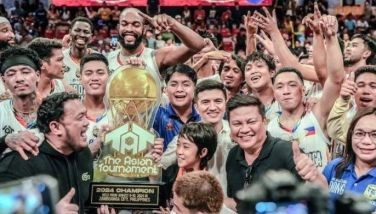RP’s improved oil dependence —a consolation for today’s tough times
July 4, 2005 | 12:00am
In our last week’s article, we talked about the "triple whammy" of higher oil prices, political uncertainty and a stronger US dollar as being the key negative factors which has been dampening the local financial markets. In all, these factors have undermined the improving domestic macro picture and the progress being achieved by the government with regard to fiscal reforms.
With oil prices already reaching the $60/barrel, local pump prices have once again increased which should put upward pressure on inflation given its direct impact on wages, transport and electricity costs.
Given such a scenario, we have taken a look at several metrics in order to ascertain the impact of sustained oil price increase to our country. However, we would like to note that we are quite fortunate that we are not as dependent on imported oil today compared to the oil shocks of the mid 70s or early 80s.
Less Dependent On Imported Oil Compared To Previous Oil Shocks
We have graphed both indigenous and imported oil as percentage to total energy demand for the country (1973 to 2004). We can see that during the major oil shocks of 1973 and 1979, the Philippines was 93 percent and 70 percent dependent on imported oil which is of course a big difference to today’s level of only 44.1 percent (as of 2004).
Over the past several years, the government has been successful in sourcing out new and indigenous sources of energy such as geothermal, hydro power, coal (e.g. Semirara Mining) and natural gas (e.g. First Gas). We have included the respective contribution of each energy source to the total indigenous energy mix in the pie chart below.
We have tracked all the administrations since 1986 and looked at their performance when it comes to improving the country’s energy mix. It shows the imported oil dependence at the start of each President’s term and the respective numbers at the end of their term. The "Net Change" column is the net improvement during their term.
We can see that Ramos had the best track record with a 16-percent improvement in energy dependence from 62 percent when he took office versus 46.1 percent when he completed his term. This was followed by the current administration with a net change of plus 10 percent from 54.3 percent in 2001 versus 44.1 percent as of 2004.
Meanwhile, the Aquino and Estrada administrations posted a minus 14.6 percent and minus 8.2-percent net change respectively.
According to the Department of Energy’s Medium Term Plan, the government is targeting to be over 62-percent self sufficient in terms of total aggregate energy mix and only 38 percent dependent on imported oil by 2010.
To achieve this, the DOE has developed a five point plan:
• Increase reserves of indigenous oil and gas
• Aggressively develop renewable sources of energy such as biomass, wind, ocean and solar.
• Increase use of alternative fuels
• Strategic alliances with other countries
• Strengthen and enhance energy efficiency
In conclusion, while its true that the country maybe experiencing hard times due to the impact of higher oil prices, we are fortunate that we are not experiencing extreme situations such as gas rationing, or long queues in the gas station as we had experienced in the oil shocks of the 1970s. If there is any "consolation" to all the difficulties we are facing right now, things would have been much worse had the government failed in sourcing out new indigenous sources of energy several years ago.
Last week, Philequity Fund had its annual stockholders meeting and Mr. Antonio R. Samson was elected as part of our board of directors. He is currently the President and CEO of Optimum Media Philippines and prior to that served as Executive Vice President of PLDT–– a company he was connected with for 21 years. He is also a respected columnist of several business dailies and is the President of the Manila Chamber Orchestra Foundation and Metropolitan Museum.
He joins our board of directors who include Washington Sycip (founder of the SGV group), Gary Teves (President of Land Bank), Vicente Jayme (Former Finance Secretary) and Enrique Esteban (President, UAP) among others.
With oil prices already reaching the $60/barrel, local pump prices have once again increased which should put upward pressure on inflation given its direct impact on wages, transport and electricity costs.
Given such a scenario, we have taken a look at several metrics in order to ascertain the impact of sustained oil price increase to our country. However, we would like to note that we are quite fortunate that we are not as dependent on imported oil today compared to the oil shocks of the mid 70s or early 80s.
Less Dependent On Imported Oil Compared To Previous Oil Shocks
We have graphed both indigenous and imported oil as percentage to total energy demand for the country (1973 to 2004). We can see that during the major oil shocks of 1973 and 1979, the Philippines was 93 percent and 70 percent dependent on imported oil which is of course a big difference to today’s level of only 44.1 percent (as of 2004).
Over the past several years, the government has been successful in sourcing out new and indigenous sources of energy such as geothermal, hydro power, coal (e.g. Semirara Mining) and natural gas (e.g. First Gas). We have included the respective contribution of each energy source to the total indigenous energy mix in the pie chart below.
We can see that Ramos had the best track record with a 16-percent improvement in energy dependence from 62 percent when he took office versus 46.1 percent when he completed his term. This was followed by the current administration with a net change of plus 10 percent from 54.3 percent in 2001 versus 44.1 percent as of 2004.
Meanwhile, the Aquino and Estrada administrations posted a minus 14.6 percent and minus 8.2-percent net change respectively.
To achieve this, the DOE has developed a five point plan:
• Increase reserves of indigenous oil and gas
• Aggressively develop renewable sources of energy such as biomass, wind, ocean and solar.
• Increase use of alternative fuels
• Strategic alliances with other countries
• Strengthen and enhance energy efficiency
In conclusion, while its true that the country maybe experiencing hard times due to the impact of higher oil prices, we are fortunate that we are not experiencing extreme situations such as gas rationing, or long queues in the gas station as we had experienced in the oil shocks of the 1970s. If there is any "consolation" to all the difficulties we are facing right now, things would have been much worse had the government failed in sourcing out new indigenous sources of energy several years ago.
He joins our board of directors who include Washington Sycip (founder of the SGV group), Gary Teves (President of Land Bank), Vicente Jayme (Former Finance Secretary) and Enrique Esteban (President, UAP) among others.
BrandSpace Articles
<
>
- Latest
- Trending
Trending
Latest




























